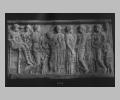
Xenokrateia Relief

Image from Svoronos
| Collection: | Athens, National Archaeological Museum |
| Title: | Xenokrateia Relief |
| Context: | From Attica |
| Findspot: | Found at New Phaleron (together with |
| Summary: | Apollo seated on a tripod, with other divinities |
| Object Function: | Votive |
| Material: | Marble |
| Sculpture Type: | Stele, relief-decorated |
| Category: | Single monument |
| Style: | High Classical |
| Technique: | Low relief |
| Original or Copy: | Original |
| Date: | ca. 420 BC - ca. 400 BC |
| Dimensions: | H. 0.57 m; W. 1.05 m |
| Scale: | Miniature (pictorial field) |
| Region: | Attica |
| Period: | High Classical |
Subject Description: Thirteen figures fill this complex scene. On the far left sits the youthful god Apollo, on his tripod; he wears a himation around his legs and lower torso. Below his feet is a bird. The remaining figures, with the exception of a woman and her child, are shown at the same scalle as Apollo and must therefore be gods (3) and goddesses (5). The female figure shown at much smaller scale (probably therefore Xenokrateia, the dedicator) stands with a nude toddler, both profile to the right. They face a youthful male figure who turns in 3/4-view towards them, and reaches down: Boardman suggests that he is Kephisos, the river god. At the far right, in the background, stands an Archaistic female figure wearing a polos--probably a Caryatid, or column sculpted in the shape of a woman. The forepart of a man-headed bull (the river god Acheloos) emerges from the left edge of the relief, in front of the Caryatid.
Form & Style: The rectangular relief is crowned by a simple narrow moulding comprised of taenia above cyma; the figures stand on a narrow plinth. The relief was supported by a large inscribed limestone base.
Condition: Complete
Condition Description: The relief form and surface are in excellent condition, marred only by a few stains on the surface, and scratches on the plinth.
Inscription: The limestone base is inscribed with a dedication by Xenokrateia to Kephisos (the river god).
Sources Used:
